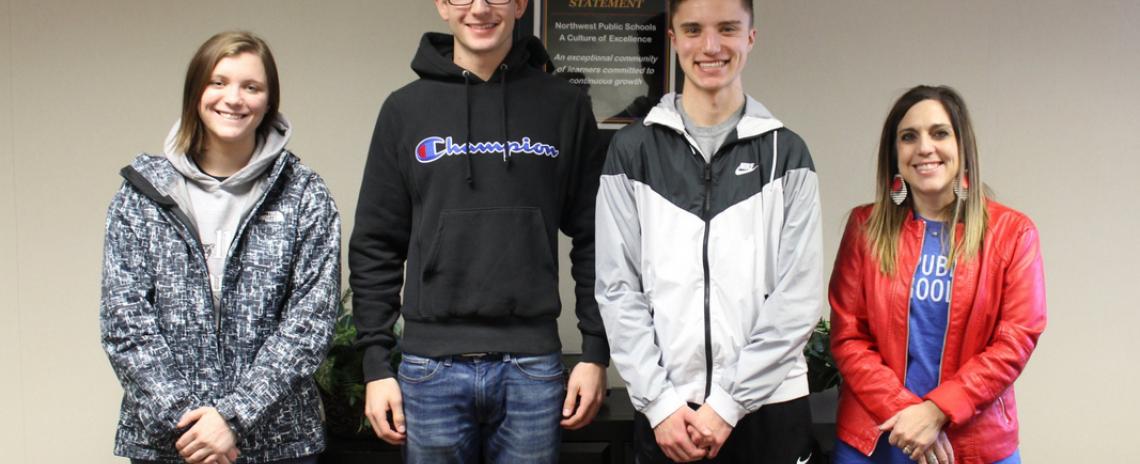Part Three: The Story
Part Three: The Story
By Tyler Dahlgren
Essentially, this is a series of stories that ends in a, well, story.
The story of a startup. The story of a school.
Taylor Siebert became fascinated with the story. Heather Callihan found her passion in the story.
“It’s like a window into your school, social media is,” Callihan said.
It’s true, the story is what gets them up in the morning, but they’re just facilitators. They don’t want to be the ones to tell it.
“The community doesn’t want to know what is going on in my world or the principal’s world,” Callihan explained. “They want to know what is happening in classrooms. They want to see things through the eyes of the students here.”
This story is theirs to tell. For Striv and the advisers at its schools across Nebraska, students are the face of opportunity. The priority, this was built for them.
“When you have a kid who watches Sportscenter every day but doesn’t play sports, and you give him or her an opportunity to still be part of the game, that’s the most rewarding part,” Siebert said. “And then they’re walking down the hallways of their school and the players are saying ‘Hey, I heard you had a great call last night.’ The level of confidence and satisfaction it’s giving those kids drives our team.”
Striv is in its seventh year. Students who became involved early in their high school careers are now nearing college graduation. Siebert and his team keep tabs on Striv kids. Recently, a professor from UNL commented on how advanced a pair of freshman were on the first day of class because of their experiences in high school.
“That’s why we wake up in the morning,” he said. “That jacks us up and gets us excited about what we’re doing.”
Tyler Rinkol will be on campus in Lincoln next fall. He’ll be a freshman pursuing his broadcasting dreams, but he’ll also be a veteran of sorts in the booth. He’s comfortable with the headset, as one of the voices of his school.
“For incoming freshmen or other kids interested in Striv, I would tell them to try it,” Rinkol said. “When I was a freshman, our former teacher (Colleen Childers) urged me to give this a try, and I was a little hesitant at first. I was scared to do it, but I quickly got used to it. If you love sports and broadcasting, this definitely helps get you experience you’ll need.”
For students like Luke Jacobs and Maddy Oakeson, whose college plans center around dentistry and biochemistry, being involved with Striv only opened additional doors. At the same time, they’re a living part of Northwest’s culture. In a way, they’re the window into their school.
“Being involved in this, I’ve got to know people I didn’t think I’d get to know in my three years here,” said Oakeson, who came to Northwest as a sophomore. “Branching out and meeting some of the most incredible people I’ll probably ever come across in life, I’ve really appreciated that aspect.”
For Jacobs, it’s the opportunities he appreciates most about his school. Opportunities like Striv, and music and sports and art. At Northwest, the production team has “Strived” music concerts and board meetings.
“Being able to take all these different classes between science, fine arts and broadcasting, it really has given me a chance to discover all my interest,” he said. “A couple months ago, for example, Tyler and I went and interviewed a couple of Husker football players for a human interest story.”
For Siebert, the scope of the story is always growing wider. StrivU was created two years ago, an online academy of students who want to become content creators.
“StrivU is a community within the Striv schools that want to go to that next level,” Siebert said.
Class Intercom, a collaboration with Social Assurance co-founder Ben Pankonin, came about because of the StrivU conferences. Class Intercom software is a tool which allows students to create content for their school’s social media outlets with moderation and approval rights. The days of sticky notes with smeared Twitter passwords are numbered.
“It just clicked,” Siebert said. “It was a natural extension of Striv. We have close to 40 schools in Nebraska. We’re in 17 different states. It’s giving students this opportunity to create social media content that they didn’t have before.”
Most importantly, adds Callihan, it’s another way to empower students.
“That’s our vision,” she said. “We want to empower students with opportunities beyond the walls, and with social media platforms to develop a voice.”
From Grand Island Northwest to Winnebago to Southern Valley to Sandy Creek, it’s time to tune in.
Schools are talking.
“The kids are creating content that is reaching people,” Callihan said. “They know what the viewers want.”
We hear you. Loud and clear.


